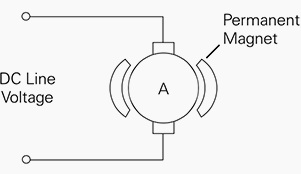Actuators - DC motors and servos
In every robotics project the robot needs to get some mobility. For mobility, we use DC motors or servos. This section will deal with motors and types of motor. The next section will deal with how we can control the motors using the Intel Edison.
Electrical motors are electromechanical devices that convert electrical energy to mechanical energy. The two electrical components in a motor are the field windings and the armature. It's a two pole device. The armature is usually on the rotor, while the field windings are usually on the stator.
Permanent magnet motors use permanent magnets to supply field flux:

Permanent magnet motor
These motors are restricted by the load they can drive, and that's a disadvantage. However, considering the fact that we are focusing on robotics and on a small-scale basis, we are opting for this kind of motor.
These motors generally operate at 9V-12V, with a maximum full-load current of around 2-3 A. In robotics, we mainly deal with three...




































































